
A jibe (US) or gybe (Britain) is a sailing maneuver whereby a sailing craft reaching downwind turns its stern through the wind, which then exerts its force from the opposite side of the vessel. It stands in contrast with tacking, whereby the sailing craft turns its bow through the wind.
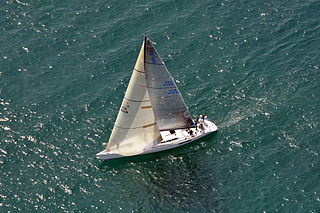
A genoa sail is a type of large jib or staysail that extends past the mast and so overlaps the main sail when viewed from the side, sometimes eliminating it. It was originally called an "overlapping jib" and later a genoa jib. It is used on single-masted sloops and twin-masted boats such as yawls and ketches. Its larger surface area increases the speed of the craft in light to moderate winds; in high wind, a smaller jib is usually substituted, and downwind a spinnaker may be used.
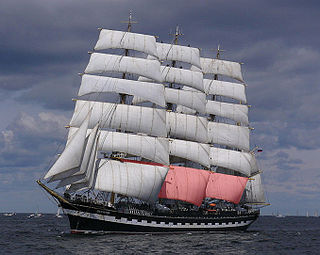
A mainsail is a sail rigged on the main mast of a sailing vessel.

Gaff rig is a sailing rig in which the sail is four-cornered, fore-and-aft rigged, controlled at its peak and, usually, its entire head by a spar (pole) called the gaff. Because of the size and shape of the sail, a gaff rig will have running backstays rather than permanent backstays.
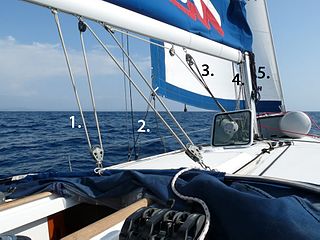
Running rigging is the rigging of a sailing vessel that is used for raising, lowering, shaping and controlling the sails on a sailing vessel—as opposed to the standing rigging, which supports the mast and bowsprit. Running rigging varies between vessels that are rigged fore and aft and those that are square-rigged.

Sail components include the features that define a sail's shape and function, plus its constituent parts from which it is manufactured. A sail may be classified in a variety of ways, including by its orientation to the vessel and its shape,. Sails are typically constructed out of flexible material that is shaped by various means, while in use, to offer an appropriate airfoil, according to the strength and apparent direction of the wind. A variety of features and fittings allow the sail to be attached to lines and spars.

A Thames sailing barge is a type of commercial sailing boat once common on the River Thames in London. The flat-bottomed barges, with a shallow draught and leeboards, were perfectly adapted to the Thames Estuary, with its shallow waters and narrow tributary rivers. The larger barges were seaworthy vessels, and were the largest sailing vessel to be handled by just two men. The average size was about 120 tons and they carried 4,200 square feet (390 m2) of canvas sail in six working sails. The mainsail was loose-footed and set up with a sprit, and was brailed to the mast when not needed. It is sheeted to a horse, as is the foresail; they require no attention when tacking. The foresail is often held back by the mate to help the vessel come about more swiftly.

In sailing, a boom is a spar (pole), along the of a fore and aft rigged sail, that greatly improves control of the angle and shape of the sail. The primary action of the boom is to keep the foot flatter when the sail angle is away from the centerline of the boat. The boom also serves as an attachment point for more sophisticated control lines. Because of the improved sail control it is rare to find a non-headsail without a boom, but lateen sails, for instance, are loose-footed. In some modern applications, the sail is rolled up into the boom for storage or reefing.

A boom vang (US) or kicking strap (UK) is a line or piston system on a sailboat used to exert downward force on the boom and thus control the shape of the sail. The Collins English Dictionary defines it as "A rope or tackle extended from the boom of a fore-and-aft mainsail to a deck fitting of a vessel when running, in order to keep the boom from riding up".
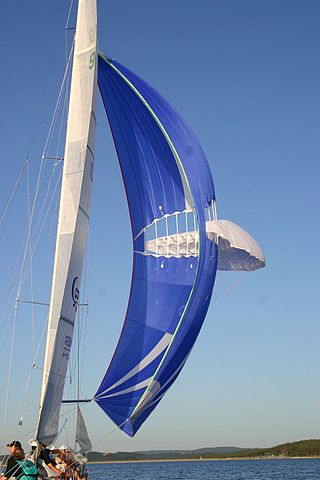
Sail twist is a phenomenon in sailing where the head of the sail is at a different angle of incidence from the foot of the sail in order to change the lift distribution with height. Twist is measured by comparing the angle of a straight line between the leading edge (luff) and trailing edge (leech) with that of the boom. Some twist is desirable, but too much can induce weather helm or ruin the slot between the mainsail and jib.

The tack of a square-rigged sail is a line attached to its lower corner. This is in contrast to the more common fore-and-aft sail, whose tack is a part of the sail itself, the corner which is secured to the vessel.
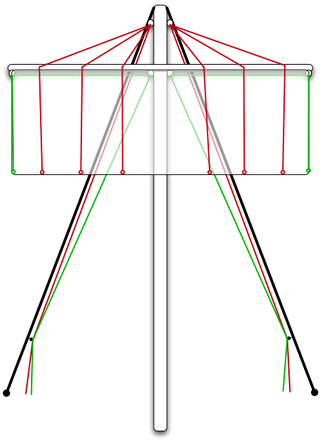
Clewlines and buntlines are lines used to handle the sails of a square rigged ship.

The crab claw sail is a fore-and-aft triangular sail with spars along upper and lower edges. The crab claw sail was first developed by the Austronesian peoples by at least 2000 BCE. It is used in many traditional Austronesian cultures in Island Southeast Asia, Micronesia, Island Melanesia, Polynesia, and Madagascar. It is sometimes known as the Oceanic lateen or the Oceanic sprit, even though it is not restricted to Oceania, is neither a lateen sail nor a spritsail, and has an independent older origin.

A fairlead is a turning point for running rigging like rope, chain, wire or line, that guides that line such that the "lead" is "fair", and therefore low friction and low chafe. A fairlead can be a hook, ring, pulley, chock, or hawse (hole) sometimes surrounded by rollers.

The junk rig, also known as the Chinese lugsail, Chinese balanced lug sail, or sampan rig, is a type of sail rig in which rigid members, called battens, span the full width of the sail and extend the sail forward of the mast. While relatively uncommon in use among modern production sailboats, the rig's advantages of easier use and lower maintenance for blue-water cruisers have been explored by individuals such as trans-Atlantic racer Herbert "Blondie" Hasler and author Annie Hill.
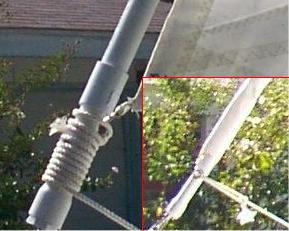
Roller furling is a method of furling a yacht's staysail by rolling the sail around a stay. Roller furling is typically used for foresails such as jibs or genoas.
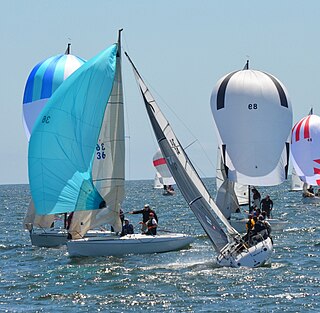
Forces on sails result from movement of air that interacts with sails and gives them motive power for sailing craft, including sailing ships, sailboats, windsurfers, ice boats, and sail-powered land vehicles. Similar principles in a rotating frame of reference apply to windmill sails and wind turbine blades, which are also wind-driven. They are differentiated from forces on wings, and propeller blades, the actions of which are not adjusted to the wind. Kites also power certain sailing craft, but do not employ a mast to support the airfoil and are beyond the scope of this article.

A sail is a tensile structure, which is made from fabric or other membrane materials, that uses wind power to propel sailing craft, including sailing ships, sailboats, windsurfers, ice boats, and even sail-powered land vehicles. Sails may be made from a combination of woven materials—including canvas or polyester cloth, laminated membranes or bonded filaments, usually in a three- or four-sided shape.

On sailboats, a sail batten is a flexible insert in a sail, parallel to the direction of wind flow, that helps shape its qualities as an airfoil. Battens are long, thin strips of material, historically wooden but today usually fiberglass, vinyl, or carbon fiber, used to support the roach of a sail. They are also used on tall ships to form the ladders up the shrouds in a fashion similar to ratlines.

A tell-tale, in a nautical or sailing context, is a piece of yarn or fabric attached to a sail, a stay, or any rigging on a sailboat. Typically, a tell-tale is on a port and a starboard stay.




















